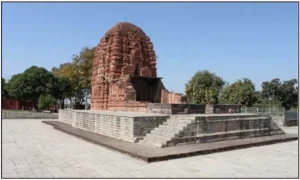India is nominating Chhattisgarh’s Sirpur archaeological site for UNESCO World Heritage status, supported by new pathways, digital displays, and improved heritage management.
About Sirpur Archaeological Site
- It is located in Mahasamund district, Chhattisgarh near Raipur on the banks of the Mahanadi.
- It was a multi-religious urban centre (5th–12th century), discovered in 1882 by Alexander Cunningham.
 Key Features
Key Features
- Excavations revealed: 22 Shiva temples, 5 Vishnu temples, 10 Buddhist viharas, 3 Jain viharas.
- Notable structures:
- Lakshmana Temple (7th-century), celebrated for its brick shikhara, sculpted door jambs and Vaishnava panels.
- Surang Tila complex with its high stepped terrace, panchayatana layout and distinct Shiva lingams.
- Tivaradeva Buddha Vihara (6th-8th century) noted for its Buddha statue and blended Buddhist–Hindu iconography.
- Remains include palace complexes, markets, residences, stupas, meditation cells, water systems, etc.
- Cultural Significance
- It was the capital of Dakshina Kosala under the Panduvanshi and Somavamshi kings.
- Displays early-medieval urban planning blending religious, civic, and commercial spaces.
- Represents a riverine cultural landscape aligning with UNESCO’s “combined work of nature and humankind” concept.
- Important centre of Buddhist learning, Shaiva and Vaishnava worship, and Jain traditions.
Process of UNESCO Recognition
- Tentative List: Country places the site on a Tentative List of potential heritage sites; nomination without listing is not allowed.
- Nomination File Preparation: Detailed Nomination Dossier prepared with documentation, maps, conservation status; UNESCO can provide technical guidance.
- Submission & Completeness Check: File submitted to the World Heritage Centre, which checks for completeness and forwards it for evaluation.
- Evaluation by Advisory Bodies: International Council on Monuments and Sites (ICOMOS) evaluates cultural sites; IUCN evaluates natural sites.
- Assessment is based on Outstanding Universal Value (OUV) criteria.
- Final Decision by World Heritage Committee: The committee meets annually and it may inscribe, refer, defer, or reject the nomination based on expert recommendations.
![]() 27 Nov 2025
27 Nov 2025

 Key Features
Key Features

